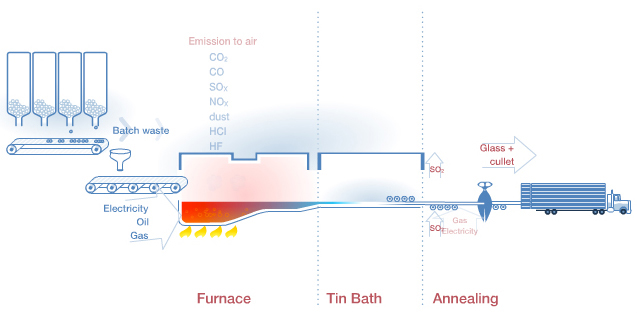Our Environmental Impact
Monitoring Our Actions
- The combustion of natural gas and the decomposition of raw materials during the melting lead to the emission of CO2. This is the only greenhouse gas emitted during the production of glass
- Decomposition of sulphate in the batch materials can release sulphur dioxide (SO2) and contribute to acidification
- High melting temperatures and the decomposition of nitrogen compounds in the batch materials contribute to nitrogen oxides (NOx) emissions and may also cause acidification and formation of smog
- Evaporation from the molten glass and raw materials may release particles into the atmosphere
Additionally, water contamination, the consumption of non-renewable natural resources including sand and minerals, the generation of solid waste and the emission of volatile organic compounds (used in production of mirrors and coatings) are also environmental concerns that we must monitor.
The steps we have taken include the complete substitution of fuel to gas for the glass melting. Although a lot has already been achieved, further reductions in emissions of SO2, dust particles, NOx and CO2 are still the main environmental targets for our flat glass activities. The AGC Group actively participates in the dynamic process of developing new techniques to help tackle the complex task of minimising and controlling these emissions in an integrated manner.
Most of these technologies come with both advantages and disadvantages. For example:
- Swapping out heavy fuel for natural gas reduces CO2 and SO2 production but increase NOx emissions
- Some NOx reduction technologies may result in an increase in CO2 when additional energy is required
- SO2 reduction technologies may generate non-recyclable waste
- Some SO2 reduction technologies are incompatible with end-of-pipe de- NOx technologies
- Some technologies can affect the lifespan of the furnace or the quality of the glass

A glass furnace operates continuously and cannot be stopped or cooled down during its lifetime (15-18 years). Therefore, the majority of technologies can only be implemented when furnaces are shut down for upgrading. This is a major challenge that forces us to “Look Beyond” and make decisions for the long run.
This report covers the major activities of the AGC Architectural Glass Division (including Upstream operations such as glass production and Downstream operations such as glass processing). The environmental impact of the downstream operations of glass processing has lower atmospheric emissions than the Upstream operations.


